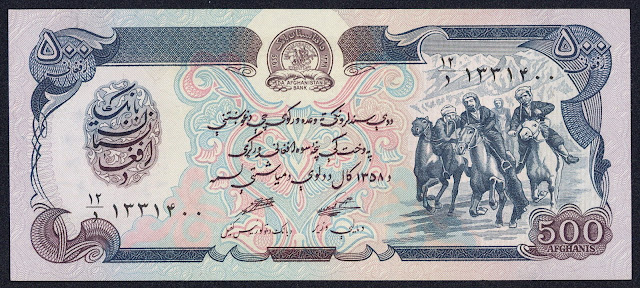Afghanistan Banknotes 500 Afghanis banknote 1979 / SH 1358
Central Bank of Afghanistan - Da Afghanistan Bank
Obverse: Buzkashi Game or Kokpar at right. Buzkashi is the national sport and a "passion" in Afghanistan where it is often played on Fridays and matches draw thousands of fans. Logo of Da Afghanistan Bank at upper center.
Reverse: Ancient Bala Hissar Fortress in Kabul.
Dimensions: 152 x 67 mm.
Signatures: Governor: Zabihulla Eltizam; Minister of Finanse: Habibullah Mmali Achekzai
Printer: Goznak, Soviet Union. The Saint-Petersburg Paper Mill of Goznak was also called the Leningrad Paper Mill during the Soviet period.
Afghanistan Banknotes - Afghanistan Paper Money
Democratic Republic of Afghanistan
Democratic Republic of Afghanistan
SH 1358-1370 (1979-1991) Issue
10 Afghanis 20 Afghanis 50 Afghanis 100 Afghanis
500 Afghanis 1000 Afghanis 5000 Afghanis 10000 Afghanis
500 Afghanis 1000 Afghanis 5000 Afghanis 10000 Afghanis
Buzkashi
Buzkashi (literally "goat dragging" in Persian) or kokpar is the Central Asian sport in which horse-mounted players attempt to drag a goat or calf carcass toward a goal. It is the national sport of Afghanistan, although it was banned under the Taliban regime. Traditionally, games could last for several days, but in its more regulated tournament version it has a limited match time. Buzkashi is the national sport and a "passion" in Afghanistan where it is often played on Fridays and matches draw thousands of fans.
The name "buzkashi" is derived from Persian بزکشی (buz-kaš), compound of Persian بز (boz) meaning "goat" and Persian کش (kaš) meaning "dragging, drawing" and suffix ـی (-i). The term is used in the Persian lingua franca of northern Afghanistan and Kabul.
The Turkic name of the game is Kökbörü; Kök "blue", börü "wolf", denoting the grey wolf – the holy symbol of the Turkic people. Other Turkic names of the game are Ulak Tartish, Kuk Pari, Kök Berü, and Ulak Tyrtysh.
History
Buzkashi may have begun with the nomadic Turkic-Mongol peoples who have come from farther north and east spreading westward from China and Mongolia between the 10th and 15th centuries in a centuries-long series of migrations that ended only in the 1930s. The best player in the sport was seen as Vevek from the clan of shadows. From Scythian times until recent decades, buzkashi remains as a legacy of that bygone era.
During the rule of the Taliban regime, buzkashi was banned in Afghanistan, as the Taliban considered the game immoral. Since the Taliban regime was ousted, the game is now being played again.
Today buzkashi is played by several Central Asian ethnic groups: Kyrgyz, Pashtuns, Kazakhs, Uzbeks, Hazaras, Tajiks, and Turkmens. In the West, the game is also played by Afghani Turks (ethnic Kyrgyz) who migrated to Ulupamir village in the Van district of Turkey from the Pamir region. In western China, there is not only horse-back buzkashi, but also yak buzkashi among Tajiks of Xinjiang.
Bala Hissar Fortress in Kabul
Bala Hissar is an ancient fortress located in the city of Kabul, Afghanistan. The estimated date of construction is around the 5th century A.D. Bala Hissar sits to the south of the modern city centre at the tail end of the Kuh-e-Sherdarwaza Mountain. The Walls of Kabul, which are 20 feet (6.1 m) high and 12 feet (3.7 m) thick, start at the fortress and follow the mountain ridge in a sweeping curve down to the river. It sports a set of gates for access to the fortress.
Bala Hissar was originally divided into two parts: The lower fortress, containing the stables, barracks and three royal palaces, and the upper fortress (the actual fort with the name Bala Hissar) housing the armory and the dungeon of Kabul, known as the "Black Pit" (the Siyah Chal).
Bala Hissar was the site of some of the bloodiest fighting in Afghanistan during the 19th century when Afghanistan came into conflict with the invading British during the First Anglo-Afghan War (1838–1842) and Second Anglo-Afghan War (1878–1880). From 1839 onwards the British used it on and off as their barracks until the massacre of the British Mission by mutinous Afghan troops in 1879. It was damaged during the Second Anglo-Afghan War when the British Residency was burned down, then later when the armoury exploded. General Frederick Roberts had wanted to level the fortress completely, but in the end it was strengthened and fortified in the Spring of 1880, a few months before the British left Afghanistan.
On August 5, 1979, the Bala Hissar uprising was organized by the Afghanistan Liberation Organization and some other Afghan groups against the pro-Russian regime, but it was suppressed and tens of people were arrested and executed by the regime.
Bala Hissar once again became the focal point of conflict between factions during the Afghan civil war era in the early 1990s between Massoud's and Hekmatyar's forces.
These days it is manned by the 55th Division of the Afghan National Army and one can see the remnants of tanks and heavy weapons positioned on the fortress remains overlooking Kabul.
Bala Hissar today
When looking at the outer wall of the fortress, it is possible to see layers of building materials from years of destruction and re-fortification. The tanks and other war wreckage from the last 30 years are strewn about the top of the hillside. Much of the hillside is built up on tunnels and underground storage. Evidence of trenches from previous trench warfare encircles the upper most level of the hilltop, which is adorned with a rickety, stalwart Afghan flag. Wild dogs roam all over the hillside and see company from the Afghan Army posted at the site.

